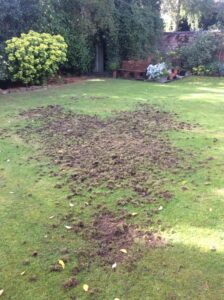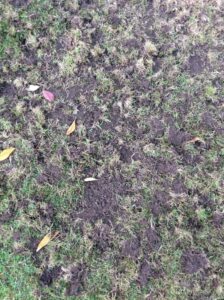3 November 2019
Customer Question – What is attacking our lawn?
Q. “Hi, We believe we had a leatherjacket infestation last autumn which was highlighted by the damage the local magpies then inflicted – see pictures below. We treated with nematodes and left the lawn alone over the rest of Autumn / winter other than to remove the debris and mow around damaged area when needed. Now it’s very early Spring and the birds still seem a bit interested, the magpies especially, but not as bad. Should we reapply nematodes, or is it too early? And is it worth trying to repair the lawn yet or will the birds keep turning it over? We had considered putting new pre-grown turf on it as it’s quite a large area but are concerned the birds will just wreck the new turf. We’ve never had this problem before in 30 years of living at this property. Your advice would be appreciated. NB. The main site of the problem was where we had a table tennis table erected for a good chunk of last years hot dry summer. Could that be why they chose that spot ( for shelter)?” from Kirstie


A. Thanks for the message and gosh they have made a mess. Unfortunately Magpies and this level of damage is more likely to be chafer grubs rather than leatherjackets so you might have treated for the wrong pest – sorry. Can you find the pest so we can make a positive identification? Try peeling back some turf where the birds are pecking and if they are digging now then they should be fairly close to the surface. Chafer Grubs are creamy coloured, approx 1.5 cm in length, have distinctive legs and will be found in the grass roots – CLICK HERE to find out more and see pictures of the pest.
Leatherjackets tend to cause areas of dieback and the birds tend to do less damage but when you are inspecting he area keep a look out for them as well – Leatherjackets are up to 2.5cm / 1″ long, greyish black in colour, legless and with no distinct head. CLICK HERE to find out more about Leatherjackets.
Once we know which pest it is (see part 2 below), we will know how best to proceed but both treatments are normally applied in April and September but recent warm conditions mean some people are already treating. Let me know how you get on. Kind regards Jon @ Green Gardener
Part 2 Answer – Thanks for the message and as suspected that is a chafer grub. You need to treat the lawn with Nemasys Chafer Grub Killer at least twice this year i.e. in April and September although as your lawn is already under attack you might want to think about adding another treatment as soon as the lawn is warm enough i.e. treat mid-March, late April and in September? The soil needs to have a daytime soil temperature of 12c and the earliest we can supply the treatment is in 2 weeks’ time? The other thing that proves very effective is to trap the adult beetles before they lay the next generation of eggs but placing a chafer trap on the lawn in May. 90% of the time this combination of nematodes and traps will control them but I just need to make you aware that there a couple of less common species of chafer grubs i.e. the welsh and summer chafer which are much harder to control and if you are unlucky and you have one of these then the treatment does take a few years to work – sorry. Fingers crossed you will have the common garden chafer which is very susceptible to the nematodes. To find out more about treating chafer grubs CLICK HERE. If you want to have a chat about the treatment, timings etc, let me know and I will give you a ring? Kind regards Jon & Green Gardener
